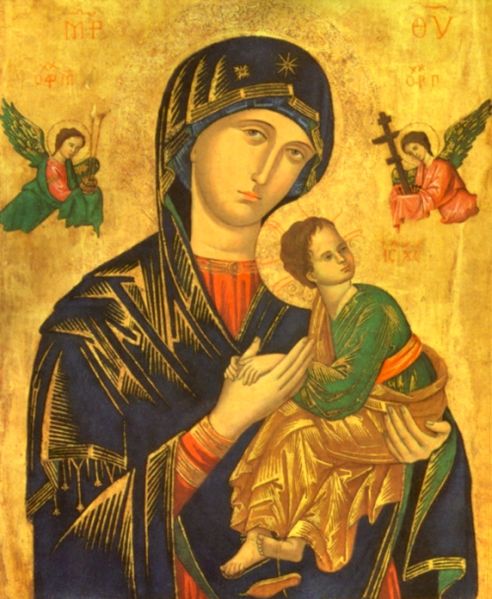
Our Lady of Perpetual Help and the Spanish Socorros
Our Lady of Perpetual Help: This iconographic type, once known as the Madonna of San Mateo for the church where the first western copy was hung, is today more often called Our Lady of Perpetual Help. It was developed in Crete as a portable icon and became popular in the West in the 15th century (Catholic Encyclopedia, s.v. "Our Lady of Perpetual Succour").
In this icon Mary engages the eyes of the viewer while the fingers of her right hand point to the Christ Child, who looks to the side. On the left an angel holds the pot, pole, and sponge used to offer vinegar to Jesus on the Cross. Also in the pot is the spear that pierced his side. The angel on the right holds a Greek-style cross with two smaller crossbars to represent the suppedaneum for Jesus' feet and the board that announced him as "King of the Jews." The Greek letters at the top abbreviate the words Meter Theou, "Mother of God."
Throughout Spain Our Lady of Perpetual Help is known as La Virgen del Perpetuo Socorro, but there two other iconographic traditions with the name Socorro. One is found in Galicia and Italy under the names Nosa Señora do Socorro: and La Madonna del Soccorso. In them Mary wields a sword to protect a child from a mostruous devil, as in the statue at left.
The other Socorro is found in southern Spain, Castile, and the Canary Islands. It is a dressed statue with the name Nuestra Señora del Socorro. Unlike the "Perpetual" Socorro, it has a crown and a fabric robe and mantle. Sometimes there are realistic tears on the cheeks. This Socorro does not defend a child from a demon.
Read more about portraits of the Virgin Mary.
Sources. Our Lady of Perpetual Help: Wikimedia Commons. Socorro: Photographed at the Museum of the Church of San Paio (St. Pelagius) in Santiago de Compostela, Spain, by Richard Stracke, shared under Attribution-NonCommercial-ShareAlike license.